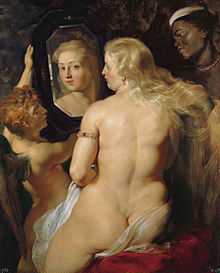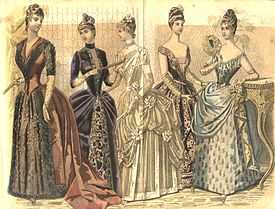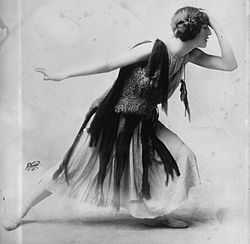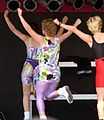Feminine beauty ideal
The feminine beauty ideal is "the socially constructed notion that physical attractiveness is one of women’s most important assets, and something all women should strive to achieve and maintain”.[1]:185
The ideal in fairy tales
The feminine beauty ideal is said to be prominent in many children’s fairy tales. It is alleged that fairy tales highlight the feminine beauty ideal and lead children, especially young girls, to believe that beauty is essential to a positive future. “Children’s fairy tales, which emphasize such things as women’s passivity and beauty, are indeed gendered scripts and serve to legitimatize and support the dominant gender system”.[1]:185 The fairy tales that we are reading to our children are emphasizing that being pretty is important and needed for a successful future. “It’s essential for parents to understand the messages our children receive about traditional gender roles, especially during a time when women are encouraged to be independent and rely on their brains rather than beauty”.[2] Beauty is often associated with the good characters and ugly and evil are shown within the bad characters. In fairy tales stories (or Disney movies), young girls are exposed to these ideas, which help them understand what it means to be a woman.[3]
The Brothers Grimm fairy tales were written by Wilhelm and Jacob Grimm in German at the end of the 18th century and first translated into English in 1823.[4] According to Grauerholz their fairy tales tend to involve a heroine, who is usually beautiful, and an evil of some sort which is characterized as ugly. Beauty and ugliness are often used as symbols to represent good and evil. Grauerholz stated in her findings that “parents need to be aware that some stories tell children that unattractive people are more likely to be evil and reinforce tradition gender roles that may be confusing for today’s young women”.[2] The Brothers Grimm fairy tales were used in central Europe to educate children on gender roles of boys and girls.[2] “Fairy tales written during the eighteenth and nineteenth centuries were intended to teach girls and young women how to become domestic, respectable, and attractive to a marriage partner and to teach boys and girls appropriate gendered values and attitudes”.[1]:186
“The lengths adolescent girls go to in seeking society’s beauty ideal, such as developing eating disorders and seeking plastic surgery, are argument enough that the preoccupation with beauty can become dangerous”.[5] Grauerholz says that the film Shrek is more realistic. “It’s the opposite of the ugly duckling story. The princess becomes the ogre in the end. But that whole movie was about twisting the fairy tales around”.[2] From fairy tales we get the feminine beauty ideal, which is: “the socially constructed notion that physical attractiveness is one of women’s most important assets and something all women should strive to achieve and maintain”.[1]:185
“Discourse analyses reveal several themes in relationship to beauty. Often there is a clear link between beauty and goodness, most often in reference to younger women, and between ugliness and evil”.[1]:187 Girls believe that beauty is related to the sense of goodness and being a princess. However, they also associate being ugly with not being good enough and having a lonely future. “Both men and women are being increasingly manipulated by media messages concerning attractiveness, a trend that is undoubtedly linked to efforts to boost consumerism. This trend does not necessarily contradict a social control perspective that suggests such messages should be directed more toward women than men”.[1]:190
The ideal in mass media
Mass media is one of the most powerful tools for young girls to learn and also understand about feminine beauty ideals. "Before mass media even existed, our ideas of beauty were limited to our own communities."[6] Because of that, people would stick to seeing each other in person in order to see the beauty ideals from one another. But as mass media developed, the way people see feminine beauty ideals changes how females view themselves and one another. Each day, girls are exposed to images of beautiful models and advertisements about beauty and fashion. “The average teen girl gets about 180 minutes of media exposure daily and only about 10 minutes of parental interaction a day, says Renee Hobbs, EdD, associate professor of communications at Temple University.”[7] In most advertisements, every female model would always portray the same kind of look. By that, they would have an ultra- thin body with an hourglass figure, beautiful soft and smooth skin/hair, and looking absolutely flawless. Because of the images that young girls are exposed to, they start to believe that physical appearance is highly seen upon every female in society. “Girls today are swamped by [ultra-thin] ideals not only in the form of dolls but also in comics, cartoons, TV, and advertising along with all the associated merchandising...”.[8]:290 Furthermore, mass media is also a way to advertise all the cosmetic products, clothing, fashionable items that girls can buy in order to become beautiful. Advertisements would “[t]arget markets to sell products such as diets, cosmetics, and exercise gear [ which helps] the media construct a dream world of hopes and high standards that incorporates the glorification of slenderness and weight loss.”[9] And because of that, girls become persuaded by media, which could lead them to buying a certain kind of product that will make them get the same results as the advertisements would say.
Social effects of the ideal
There are consequences when young girls learn about feminine beauty ideals. When girls are exposed to the ideas about feminine beauty that are circulated throughout the media, negative impacts on their well-being can be seen. Research indicates "...women exposed to television for even a very short time experienced decreased mood and self-esteem and had a lower opinion of their bodies”[10] Because of the media, “...[g]irls learn that their bodies should be used to attract others.”[9]:2 They tend to follow that kind of ideology. In Disney movies and fairytales stories, beauty is often associated with skin color. The majority of the main (and supporting) female characters are often associated with having light skin, which represents goodness and beauty, while the antagonist is associated with dark skin, which represents badness and ugliness. For young girls who read or watch these movies or stories, they will get the idea about their skin color and how they are seen in society. Those who are dark-skinned could develop low self-esteem because of that. Besides skin color, there is also body image that is a major concern for female in today's society. “Body image becomes a major issue as females go through puberty; girls in midadolescence frequently report being dissatisfied with weight, fearing further weight gain, and being preoccupied with weight loss.”[11]
Having low self-esteem can also lead to depression. This happens a lot with girls around the world. The more they are exposed to all the ads in magazine, commercials, or billboards with thin looking models; they feel as though they have to be that way. “Thus, social comparison theory would predict that women may compare themselves to societal standards of beauty in order to assess their own level of attractiveness.”[12]:154 There is a lot of pressure for girls to conform to the feminine beauty ideals and that they must understand they need to look a certain way in order to be accepted in society. Girls who do not categorize as being thin but want to be, tend to go on an exercise plan, a diet and even worse, develop eating disorder. "By promoting an ideal of feminine beauty that is impossible to achieve for the average woman, the media created increased dissatisfaction with one's body which may lead to weight control behavior and increased risk for developing eating disorders.”[13]:112 Girls who tend to develop eating disorder would start to have health issues. Furthermore, "Men place more importance on the physical attractiveness of women than women do on the physical attractiveness of men."[14]:281 Because of that, women tend to look their best for the male gaze. This gives even more pressure for women to look their best at all times.[3] Women and girls should be happy with the way they are but due to the media and society they all want to be fit and blend in.
Gallery
-

Venus at a Mirror, Peter Paul Rubens, 1615. During the Renaissance era, blonde hair and full-figured bodies were idealized.[1]
-

Victorian women were highly body conscious. They wore corsets to reduce their waistline, and bustles and petticoats that magnified their derriere.[1]
-

Actress Marilyn Monroe was perceived as the epitome of beauty in the 1950s.[2] She popularized the hourglass figure.
-
Farrah Fawcett and Cher in 1976. From the 1960s up to the 1980s, women aimed to look skinny. Tanned skin also became popular.[1]
- ^ a b c d e "A Timeline of Sexy Defined Through the Ages". Discovery News. StyleCaster. 19 March 2010. Retrieved 3 March 2014.
- ^ a b "The Ideal Woman Through the Ages: Photos". Discovery News. Discovery Communications. 12 December 2012. Retrieved 3 March 2014.
References
- ↑ 1.0 1.1 1.2 1.3 1.4 1.5 Spade, Joan Z; Valentine, Catherine (Kay) G (2010). The Kaleidoscope of Gender: Prisms, Patterns and Possibilities (Third ed.). SAGE Publications, Inc. ISBN 978-1412979061.
- ↑ 2.0 2.1 2.2 2.3 Baker-Sperry, Lori; Grauerholz, Liz (October 2003). "The Pervasiveness and Persistence of the Feminine Beauty Ideal in Children's Fairy Tales" (DIGITAL SCAN). Gender & Society (Sage Publications) 17 (5): 711–726. doi:10.1177/0891243203255605. ISSN 0891-2432. JSTOR 359470. Retrieved 10 March 2013.
- ↑ 3.0 3.1 :185
- ↑ "About the Brothers Grimm". Retrieved 10 March 2013.
- ↑ Hanafy, Erin (13 January 2004). "New study questions fairy tales’ preoccupation with beauty". kids & families. Phoenix: The Arizona Republic. Retrieved 10 March 2013.
- ↑ unknown, Body Image. (n.d.). - The Media Lies. Retrieved October 26, 2013, from http://www.ourbodiesourselves.org/book/excerpt.asp?id=2
- ↑ Heubeck, Girls and Body Image: Media's Effect, How Parents Can Help. WebMD. Retrieved October 26, 2013, from http://www.webmd.com/beauty/style/helping-girls-with-body-image
- ↑ Dittmar, H.; Halliwell, E.; Ive, S. (2006). "Does Barbie make girls want to be thin? The effect of experimental exposure to images of dolls on the body image of 5- to 8-year-old girls". Developmental Psychology 42 (2): 283. doi:10.1037/0012-1649.42.2.283.
- ↑ 9.0 9.1 Groesz, L. M.; Levine, M. P.; Murnen, S. K. (2002). "The effect of experimental presentation of thin media images on body satisfaction: A meta-analytic review". International Journal of Eating Disorders 31 (1): 1–16. doi:10.1002/eat.10005.
- ↑ Renzetti, Claire M.; Curran, Daniel J.; Maier, Shana L. (2012). Women, Men, and Society (6th ed.). Pearson. p. 157. ISBN 9780205459599.
- ↑ Sedar, Kasey. "The Myriad: Undergraduate Academic Journal." Westminster College: A Private Comprehensive Liberal Arts College in Salt Lake City, UT, Offering Undergraduate and Graduate Degrees in Liberal Arts and Professional Programs, including Business, Nursing, Education and Communication. N.p., Spring 2005. Web. 16 Oct. 2013.
- ↑ Evans, P. C. (2003). Do Racial Minorities Respond in the Same Way to Mainstream Beauty Standards? Social Comparison Processes in Asian, Black, and White Women. Self and Identity, 2, 153-167.
- ↑ Mondini, S.; Favaro, A.; Santonastaso, P. (1996). "Eating Disorders and the Ideal of Feminine Beauty in Italian Newspapers and Magazines". European Eating Disorders Review 4 (2): 112–120. doi:10.1002/(SICI)1099-0968(199606)4:2<112::AID-ERV152>3.0.CO;2-6.
- ↑ Mazur, A. (1986). "U.S. Trends in feminine beauty and overadaptation". Journal of Sex Research 22 (3): 281–303. doi:10.1080/00224498609551309.
| ||||||||||||||||||||||||||||||||||||||||||||||||||||||||||
| ||||||||||||||||||||||||||||||||||||||||||||||||||||||||||||||||||||||||||||||||||||||||||||||||||||||||||||||||||||||||||||||||||||||||||||||||||||||||||


